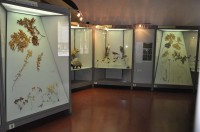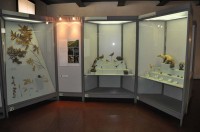Woodland Formations
The forests that cover much of the Berici Hills are far from homogeneous: based on the plant species characterizing them, they can be divided into three basic types: Ostrieto (mainly black hornbeams; particularly widespread and prevalent on the summits), Querceto (mainly oaks; located on the relatively dry and warm southeastern slopes), and Castagneto (mainly chestnut trees; more associated with cool and moist soils).
This diversity in forest vegetation is primarily determined by local differences in climate and rocky substrate, which in turn influences the fauna that interacts with it. For each of the three forest types, therefore, the panels and display cases in the room illustrate not only some of the most characteristic trees, shrubs, and herbs (with photographs and dry-preserved plants) but also a selection of the most typical or rare animal species, from small insects that damage the bark or feed on the leaves, to the migratory or nesting birds that inhabit the canopy, to the reptiles and mammals moving through the undergrowth.
Image Gallery
 |
 |

